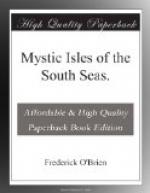The pandanus likes the coral sand, and is in appearance a tree out of a dream. It grows twenty feet high and stands on aerial roots resembling inclined stilts. The leaves are in tufts at the tips of the branches, set like a screw, twisting around the stem in graceful curves, and marking the stem with a spiral pattern from the root upward. The leaves are edged with spines. The wood is close, hard, and hollow, and full of oil. From the pandanus are made posts five or six inches through. The leaves, four or five feet long, are torn into strips for making hats, thatch, mats, and canoe sails. They are steeped in sea-water, and beaten with a mallet to remove the green outer skin, the residue being white, silken fiber. This is dyed to weave hats and belts. The aerial roots are crushed to make a tougher fiber for ropes, baskets, and mats. The fruit is something like a coarse pineapple, and the blossoms are very fragrant. The ripe fruit is crimson, and strings like beads into favorite necklaces. The fruit separates into cones, and one chews the inner end like licorice, while, when dried, the kernels can be ground into a brown, sweet flour for cakes, a wholesome, nourishing food, but esteemed only in more barren islands, where fish and cocoanuts are the principal diet. From the fruit is distilled a fiery liquor that the early whalers taught the line islanders to drink.
At the isthmus was the only crossing of the belt or, Broom Road, about Tahiti. One had to choose the left or the right, and we wound to the right to reach the Maison des Varos. To the left we could have gone to Tautira, famous as the last stand of the god Oro against the cross, and still under the chieftaincy of Ori-a-Ori, with whom R.L.S. and his family lived several months.
The road was a fairy-tale brightly illuminated by plantation, jungle, and garden, by reef and eyot. The sea lapped gently on sand as white as the fleecy clouds. Carts of Chinese and Tahitians passed, carrying their owners and produce. The Chinese said, “Yulanna!” for “Ia ora na!” and the natives called to us to eat with them in their near-by homes. But we walked on, saying, “Ua maururu!” “Much obliged!”
M. Butscher had a good-sized, rambling house, with verandas for dining, and bedrooms for sleep. We found him on his largest table, lying flat on his back, and contemplating, in the eternal and perplexing way of the Polynesians. The Daibutsu, the great Buddha of Kamakura, had no more peaceful, meditative aspect than had the Taravao taverner. He was long and meager, as dry as a cocoanut from the copra oven, as if all the juices of his body and soul had been expressed in his years of cooking the sea-centipedes for which he was celebrated. Tatini addressed him slowly: “Bocshair, ia ora na!”
He sat up stiffly, and regarded us with indifference. He was cast for an old and withered Mephistopheles, his lines all downward, his few teeth fangs, and his smile a threatening leer, as if he thought of a joke he could not tell to decent visitors, but which almost choked him to withhold. His clothes were rags, and his naked feet like the flippers of seals. He opened his mouth, yawned, and said, “Iiii,” a word which means, “I slept with my eyes open.”




